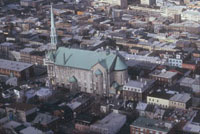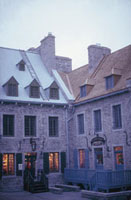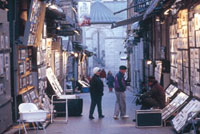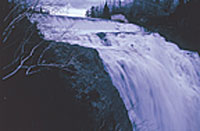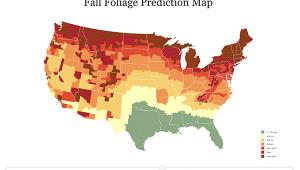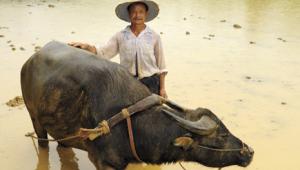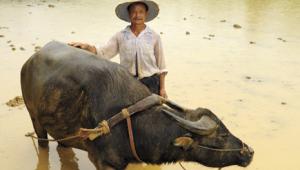Quebec City
A Little France North Of The Border
Quebec City is as close as you can get to Paris without flying over the Atlantic. It feels, thinks and acts French, and is the cradle of French culture in North America. It's a great place to simply immerse yourself in ambiance or photography. In fact, it's a good idea to do both, and your images will show it. Making interesting photographs means adopting an attitude--in the good sense of the word. Simply shoot anything and everything you would want to show people about the city. Take a walk along the twisty narrow streets of the Old Town section and it feels like you are on the Left Bank of the Seine--only it's the St. Lawrence. Quebec City has the look, feel, and atmosphere of Paris with a few Canadian overtones. Even the more modern part of the city has a very Parisian feel--but more like the Right Bank. No matter where you go in Quebec City the language is French--although most people do speak English but with a decided accent that reinforces the feeling of being in Paris. In fact, in colonial times Quebec was the capital of New France. Then came the conflict with England and New France disappeared. Quebec is the only fortified city north of Mexico in North America. Of course, the fortifications date from colonial times but the walls are still more or less intact. Wander around the old city and you will discover the original cannons in place waiting for British or American ships sailing up the St. Lawrence River. |
|||
Like Paris this city also has its Notre Dame, a Basilica with an Old World interior. The light level is high enough to make available light practical with a little support from columns and bench backs. I try to shoot at around f/5.6 for as much overall sharpness as possible when photographing interior subjects. The lower part of the Old Town is reached via a series of staircases that provide a terrific aerobic workout on the way back to the upper part of town. There's also a cog railway that makes getting up and down a lot easier on the legs. The Place Royale in the lower town looks much the way it did in colonial times--with a bit of restoration. Mansard roofs on the buildings add to the European feeling of the place. Narrow streets offer art galleries, restaurants, and the Musée de la Civilization. But simply walk the streets of the lower town and you'll stumble on subjects that in your mind's eye will become fantastic images. There is a marvelous mural of a street scene done by a group of Quebec and French artists that has an amazing three-dimensional effect. It's a challenge to find the right spot and camera angle to capture the effect but it's worth the time and effort. One of the really great places to stay in the Old Town is the Château Frontenac. During spring and summer it tends to be a bit pricey. Off-season it's considerably less expensive. The Château Frontenac is a beautiful building that was constructed in stages but somehow manages to have a cohesive feeling. Inside it may take a day or two to learn the best way to get around. Shops in the hotel are interesting but pricey like all tourist hotels. |
|||
The favorable rate of exchange does help. And the hotel restaurant is good but it's fun to venture out and try some of the eating places on both levels of the old city. Due to the strong French influence it's difficult to find a bad restaurant. The hotel itself is an interesting photographic subject but it takes some wandering around to find an image that grabs you. The best place to photograph the hotel may be from a low angle in the lower part of Old Town. You may also find yourself going up and down the connecting staircases more than once a day simply looking for images. It's a good workout and justifies the tendency to overeat. Colorful kiosks plastered with posters announcing coming events are all over the old city. They make great foreground images with the St. Lawrence, horse drawn carriages, or old buildings in the background. And like Paris, Quebec City has its little parks. In winter there's a skating rink in a park near St. John's Gate. You do need flash unless you shoot before sundown and at night the lighting is too low even for faster films. The skaters and the gate combine for a wonderful winter image and the parks themselves make interesting cityscapes. Be sure to shoot just before or after sundown when the park lights are on. You'll need at least an ISO 400 or faster color or black and white film. A 50mm f/1.4 or 24mm f/2.8 wide angle lens is a good bet for night shooting in Quebec. A lightweight tripod makes it possible to shoot cityscapes with virtually any lens. |
|||
The Capital Observatory offers what is probably the most stunning view of Quebec City. It has a 360° viewing window located on top of the Edifice Marie-Guyart, the tallest building in Quebec. It provides a chance to make images of the city that would be impossible except from a low flying helicopter or airplane. The glass is absolutely clean but you can't move in close enough to eliminate reflections. A polarizing filter did the job for me. Think depth of field for overall sharpness and load with ISO 100 or 200 depending on the light and time of day. Toward evening you might want ISO 400 or faster. Not far from the observatory is the Quebec Parliament building. The building has stained glass windows, impressive staircases and the lighting is interesting. The provincial Parliament itself is an insight into the complex politics of Quebec. Unless you've been living on Mars you've heard about the various factions that make the province a contentious, fascinating political arena. |
|||
There are some great picture possibilities outside the city limits. A trip to the waterfall at Parc De la Chute-Mont-morency is worth the time and you can combine it with other attractions. Drive there via Avenue Royale Est where it joins Côte de Beaupré. The falls are actually higher than Niagara but not as wide. I like shooting there just before and slightly after sunset. You'll need at least an ISO 400 or faster film and a light tripod. There's also a cable car and a suspension bridge that offer overwhelming views. You might want to combine the trip to the falls with an earlier stop at St. Anne de Beaupré. It is a striking example of church architecture and has a rather impressive replica of Michelangelo's Pietà. And if the name St. Anne is familiar it may be because the area offers some of the best skiing in North America. Mount St. Anne is not all that far from Quebec City. Back in Quebec City visit the Gallery Art Inuit just down the street from the Château Frontenac. It is devoted to art that reflects the life of native Canadians that words could not duplicate. Quebec City is a great place to visit, photograph, or simply wander around in, letting the city itself guide your steps. From a photographic point of view you can't go wrong by simply letting your feet and eyes guide you and reacting as images present themselves. |
